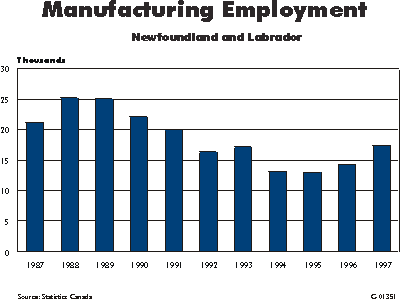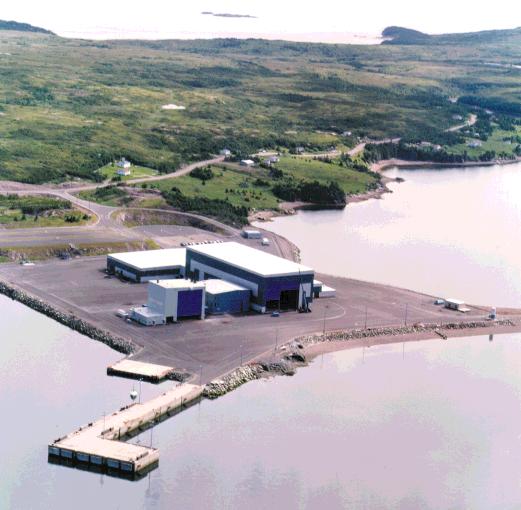The Economy 1998
Manufacturing
The Province's manufacturing industry recorded a strong performance in 1997,
characterised by gains in shipment volumes for newsprint, fish and refined petroleum
products. Employment gains were recorded, despite a drop in the value of shipments
stemming from price declines. Manufacturing employment fell during the early 1990's with
the closure of the groundfishery, but has rebounded by about 34 percent since its low in
1995.
 While fish, paper and petroleum products are dominant,
manufacturing has become increasingly diverse, involving a wide variety of products.
Technology-based products, from satellite communications and medical technology to defence
and environmental technology, have flourished. Similarly, traditional manufactures such as
footwear, furniture and other high valued wood products have shown significant growth.
Coupled with the recent privatization of marine vessel construction and industrial
fabrication facilities such as the Marystown Shipyard and Newfoundland Dockyard, these
trends have been positive for job creation.
While fish, paper and petroleum products are dominant,
manufacturing has become increasingly diverse, involving a wide variety of products.
Technology-based products, from satellite communications and medical technology to defence
and environmental technology, have flourished. Similarly, traditional manufactures such as
footwear, furniture and other high valued wood products have shown significant growth.
Coupled with the recent privatization of marine vessel construction and industrial
fabrication facilities such as the Marystown Shipyard and Newfoundland Dockyard, these
trends have been positive for job creation.
The recent success enjoyed by the manufacturing industry has been fostered by a dynamic
approach to development and diversification on behalf of business, academia and
government. Industry and training facilities have collaborated to ensure that firms have
access to technical expertise, world class research facilities and a highly skilled labour
force. Other programs, such as Manufactured Right Here, are designed to alert residents to
the wealth of competitively priced, high quality products that are available from domestic
producers. Manufacturers have also sought more aggressive development of export sales as
the Province is strategically positioned to serve European and NAFTA markets.
Government initiatives have focused on reducing both the tax burden and administrative
complexity facing firms. Achievements on this front include the lowest corporate tax rates
for manufacturing and processing in the Country, exemptions from municipal tax assessment
and research and development tax credits. Others include harmonisation of the Provincial
RST with the federal GST which allows businesses full input tax credits, the EDGE
program–a combination of tax and other incentives, and the Province's Regulatory
Reform Program which addresses bureaucracy and regulation on an ongoing basis.
Recent efforts to enhance the Provincial business environment are paying off. Last year
a KPMG study (outlined on page 19) named St. John's the most cost-effective place to do
business. The study of 42 cities in seven countries examined eight location-sensitive cost
factors for eight industries–St. John's came out on top in all industries and
received the number one ranking. Also, an analysis by the Alliance of Manufacturers and
Exporters of Canada has determined that over the past five years, Newfoundland and
Labrador together with three other provinces enjoyed the strongest manufacturing
productivity growth in the Country.
OUTLOOK
The Province's manufacturing industry is poised to continue its expansion in 1998.
Overall, the value of manufacturing shipments is expected to rise by four percent this
year, driven by anticipated strong performances by the fish, newsprint and petroleum
industries. These commodities are export driven and will be aided somewhat by the
depreciation of the Canadian dollar vis-à-vis the US dollar. Gains in other types of
manufactures are expected to continue at a healthy pace as strengthening consumer
confidence fuels domestic demand. The strategy of diversification and innovative product
development should enjoy further success in this and coming years.
FRIEDE GOLDMAN NEWFOUNDLAND Shipbuilding and repair has been and will continue to be an integral part
of the manufacturing industry in this Province, facilitated by the importance of the
fishing industry and shipping as a mode of transportation. The growth of the oil industry
has added another important dimension to the sector.
The largest player in this sector is Friede Goldman Newfoundland (formerly Marystown
Shipyard Ltd.). Friede Goldman Newfoundland was created when Friede Goldman International
Inc. (FGII) acquired the Marystown Shipyard Facility and the Cow Head Fabrication Facility
on January 1, 1998 from the Provincial government. The acquisition is a positive
development for Newfoundland and the Burin peninsula in particular. The new owners have
committed to obtaining activity at the yard sufficient to maintain a minimum of 600 person
years of work at Marystown for the next three years. The Company will also undertake a
capital investment program of $5–$15 million over the next few years to make
immediate improvements at the facilities.
The Company currently employs about 730 people and is the largest fabricator in
Newfoundland, operating two of the best equipped and most efficient deepwater, ice free
facilities of their size on the Eastern seaboard of North America.
FGII is a leading provider of offshore drilling services and the Marystown facility
intends to aggressively pursue and capture work associated with the conversion and
building of offshore drilling rigs. |
Main Page Contents Previous Next
 While fish, paper and petroleum products are dominant,
manufacturing has become increasingly diverse, involving a wide variety of products.
Technology-based products, from satellite communications and medical technology to defence
and environmental technology, have flourished. Similarly, traditional manufactures such as
footwear, furniture and other high valued wood products have shown significant growth.
Coupled with the recent privatization of marine vessel construction and industrial
fabrication facilities such as the Marystown Shipyard and Newfoundland Dockyard, these
trends have been positive for job creation.
While fish, paper and petroleum products are dominant,
manufacturing has become increasingly diverse, involving a wide variety of products.
Technology-based products, from satellite communications and medical technology to defence
and environmental technology, have flourished. Similarly, traditional manufactures such as
footwear, furniture and other high valued wood products have shown significant growth.
Coupled with the recent privatization of marine vessel construction and industrial
fabrication facilities such as the Marystown Shipyard and Newfoundland Dockyard, these
trends have been positive for job creation. 